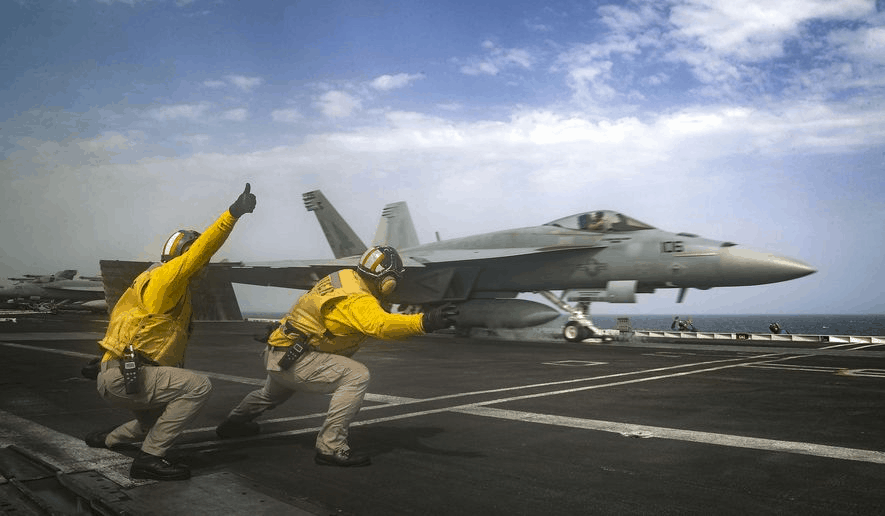China targeting U.S. Navy warships with electromagnetic weapons

China has called for using electromagnetic attacks on U.S. warships transiting the South China Sea, according to a state-run Chinese outlet.
The Communist Party-affiliated organ Global Times, quoting a military expert, said the use of nonlethal electromagnetic and laser weapons should be used by the People’s Liberation Army to expel American warships from the disputed sea.
The report followed China’s potentially dangerous use of a laser against a Navy P-8A maritime patrol aircraft near Guam last month, and an earlier lasing two years ago of C-130 aircraft near China’s military base in Djibouti on the coast of Africa.
The article was published Tuesday, the same day the Pacific Fleet announced on Twitter that the aircraft carrier strike group led by the USS Theodore Roosevelt, and the USS America, an amphibious assault carrier and leader of an expeditionary strike group, were conducting exercises in the South China Sea.
The training exercise for both strike groups included flight maneuvers, air defense tests and surface-support mission exercises, the fleet said in a report on the exercises. At one point, Marines carried out a simulated visit, board, search and seizure exercise on the guided missile cruiser USS Bunker Hill, according to the report.
“Training with multiple platforms really enhances the overall combat capability of the force,” said Capt. Kurt Sellerberg, commanding officer of the Bunker Hill. “Cruisers and destroyers, being multi-mission platforms, can complement and support strike operations with the Marine Air Wing (MAW) from the America [Expeditionary Strike Group].”
The large-scale military maneuvers are a direct challenge to China’s claims to control 90% of the South China Sea, despite an international court ruling several years ago rejecting those claims. The Global Times report said the carrier operations marked the third time in the past week that U.S. warships have “trespassed” into the sea.
The Pentagon has said repeatedly that it regards the sea as international waters and frequently conducts freedom of navigation operations through the sea.
Other recent warship operations included the passage of the guided missile destroyer USS McCampbell on March 10 to waters near the Paracel Islands in the northern part of the sea and maneuvers by the America and a littoral combat ship, the USS Gabrielle Giffords, on March 13.
Song Zhongping, a Chinese military commentator formerly with PLA missile forces, said the Chinese military has the option of using electromagnetic and other advanced weapons to counter the U.S. warship passages. Firing conventional weapons could trigger a conflict while using ramming techniques, as tried in 2018 against a U.S. warship, also is not a good method, he noted.
Mr. Song said that using electromagnetic weapons, including lasers, could temporarily paralyze U.S. warships’ weapons control systems “without visible conflict but can send a strong warning.” Electromagnetic arms emit pulses of energy that can jam electronics.
Mr. Song said the Feb. 17 laser incident involving a Navy P-8A was carried out after the aircraft conducted repeated close-in reconnaissance of a Chinese warship.
“This is a good example and could be applied more,” Mr. Song, with PLA-linked Phoenix television, was quoted as saying about the lasering.
The threatening report is viewed by some analysts as an indication that China may be preparing to conduct some type of provocative action in the South China Sea.
Photo: In this Thursday, May 16, 2019 photo released by the U.S. Navy, Lt. Nicholas Miller, from Spring, Texas, and Lt. Sean Ryan, from Gautier, Miss., launch an F-18 Super Hornet from the deck of the USS Abraham Lincoln aircraft carrier in the Arabian Sea. On Saturday, May 18, 2019, U.S. diplomats warned that commercial airliners flying over the wider Persian Gulf faced a risk of being "misidentified" amid heightened tensions between the U.S. and Iran. (Mass Communication Specialist 3rd Class Jeff Sherman, U.S. Navy via AP)
Link: https://www.washingtontimes.com/news/2020/mar/19/china-putting-bulls-eye-us-navy-warships-electroma/











